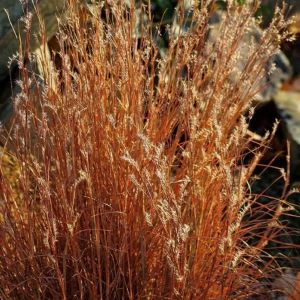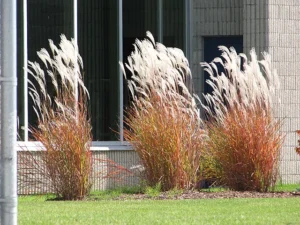Summary
Learn how to plant and care for Ornamental Grasses in the landscape.
Ornamental Grasses are incredibly easy to grow and care for, but they do require some annual maintenance to look their best. The most common questions we get about grasses are:
- When should you plant Ornamental Grasses?
- When and how should you cut Ornamental Grasses?
- How and when to divide Ornamental Grasses?
In this blog, we’ll get to answering these questions and share some tips about care for Ornamental Grasses. First, let’s go over some basic terminology that’ll come in handy when discussing grasses.
What is the difference between Warm Season and Cool Season Grasses?
When selecting grasses, you’ll probably come across the terms warm-season and cool-season. This refers to the season that a grass will do most of its growing in:
- Cool Season Grasses put on much of their growth during the cooler seasons, particularly in Spring and then again in Fall when temperatures are below 75 degrees F. They typically go dormant during the heat of the Summer, though they still retain good color and form.
- Warm Season Grasses don’t usually start pushing new growth until mid to late Spring or early Summer when temperatures are consistently warmer. They often turn brown later in the season or, in the case of Bluestems and Switchgrasses, will turn shade of yellow to red or purple in the Fall.
- Evergreen Grasses refers to a group of unrelated plants such as sedges (Carex), rushes (Juncus), or lilyturf (Liriope) that look like true grasses and have blade-like evergreen foliage.
- Annual Grasses are grasses that are not cold-hardy in temperate climates and will not survive through freezing temperatures. They are planted as annuals for their bold impact in containers and other focal point areas.
When it comes to how to care for Ornamental Grasses, there isn’t too much of a difference between warm and cool season grasses.
Popular Warm Season Grasses include:
- Big Bluestem (Andropogon)
- Grama Grass (Bouteloua)
- Hardy Pampas Grass (Cortaderia/Erianthus)
- Maiden Grass (Miscanthus)
- Purple Moor Grass (Molinia)
- Muhly Grass (Muhlenbergia)
- Switchgrass (Panicum)
- Fountain Grass (Pennisetum)
- Little Bluestem (Schizachyrium)
- Indiangrass (Sorghastrum)
- Dropseed (Sporobolous)
- Alkali Sacaton (Sporobolus)
Popular Cool Season Grasses include:
- Indian Rice Grass (Acnatherum/Eriocoma)
- Feather Reed Grass / ‘Karl Forester’ (Calamagrostis)
- Tufted Hair Grass (Deschampsia)
- Fescue (Festuca)
- Blue Oat Grass (Helictotrichon)
- Sweetgrass (Hierochloe)
- Great Basin Wild Rye (Leymus)
- Mexican Feather Grass (Nasella/Stipa)
- Autumn Moor Grass (Sesleria)
What is a bunch type grass?
You may also see the terms “bunch grass” or “sod-forming grass.” These terms refer to the ways in which grass roots grow. Bunch grasses form circular clumps that slowly expand outward from the center, while sod-forming grasses spread laterally through rhizomes. Most ornamental grasses are bunching or clumping. Some, such as Fescues or Grama grasses (Bouteloua), are sod-forming types which makes them good alternatives to traditional lawns.
What are Prairie Grasses?
You may also see some Ornamental Grasses referred to as prairie grasses. Until relatively recently, much of the central United States was covered in large prairies made up of a variety of grasses and other plants. These North American native grasses often have deep taproots to take advantage of sporadic rainfall, making them resilient and drought-tolerant. They also provide great value for native wildlife and pollinators.

Some commonly cultivated prairie grasses include:
- Big Bluestem (Andropogon)
- Grama Grass (Bouteloua)
- Muhly Grass (Muhlenbergia)
- Switchgrass (Panicum)
- Little Bluestem (Schizachyrium)
- Indiangrass (Sorghastrum)
- Prairie Dropseed (Sporobolus)
Do grasses need full sun?
Most ornamental grasses prefer sunny conditions, handling both full to partial sun and hot temperatures. Prairie grasses are particularly sun and heat tolerant. Shade-tolerant grasses include Japanese Forest Grass (Hakonechloa), Mondo Grass (Ophiopogon), and most “grass-like” plants. These plants actually need partial to full shade, especially in climates with hot, dry summers.
How much Sun or Shade does your area get?
Full Sun: 6+ hours a day of direct sunlight
Partial Sun: 4-6 hours a day, or more filtered sunlight
Partial Shade: 2-3 hours a day direct or filtered sunlight
Full Shade: Less than 2 hours of sunlight per day
Are Ornamental Grasses drought-tolerant?
Many ornamental grasses are considered to be drought tolerant, though a better term for a plant’s low water dependency would be waterwise. Prairie grasses, as well as Feather Reed Grasses (Calamagrostis) are both drought tolerant and waterwise, and don’t like to be overwatered or have “wet” feet. Some grasses, including Fountain Grasses (Pennisetum) and Maiden Grasses (Miscanthus), though, do appreciate supplemental watering a bit more often, especially in the heat of the Summer.
What is the best time to plant Ornamental Grasses?
The ideal time to plant ornamental grasses is, as with many plants, during the cooler seasons of Spring and Fall. Planting in the Summer or even Winter, is perfectly fine, although grasses will remain mostly dormant during high heat and cold temperatures. Whenever planting, but especially in the Summer, make sure that you water your plants regularly through the time it takes to establish.
What kind of soil do Perennial Grasses need?
Grasses are not picky when it comes to soil. Most all grasses that you’ll find in the nursery are tolerant of poor draining and inert soils, and don’t need and special soil amendments when planting. They can handle both clay and sandy soils, as well as salty, dry, alkaline soils that are common in Utah and the West. Grasses, especially native and prairie grasses can also tolerate the salty Secondary or Irrigation water that many other plants cannot, making them invaluable in the landscape.
Do Ornamental Grasses need to be cut back every year?
Ornamental Grasses grow to their full height in each growing season in temperate climates, which means that they need to be cut back before flushing out new growth in Spring or Summer. While the most common trend is to cut back these grasses in the Fall, they can actually be left until the Spring, adding texture to the Fall and Winter landscape with their stalks and plumes. Either way, you should plan cutting back once a year in your routine care for Ornamental Grasses.
Note: Some grasses such as Mexican Feather Grass, Fountain Grasses and some native grasses will readily self seed, so it may be advantageous to cut them back in the Fall so as to prevent their spread.
How should you trim Ornamental Grasses?
Whether trimming in the Fall or early Spring, we recommend cutting grasses back to the base, leaving just a few inches of growth above the ground. Smaller grasses can be managed with pruners or shears, but taller grasses with thicker stalks will need bigger tools such as electric hedge trimmers or even a chainsaw. Most grasses have sharp foliage (they’re called blades for a reason!) so be sure to wear gloves and long sleeves when handling them.
Cleanup Tip: Tie up your grasses into sheaves for easy cutting. Tying grasses up in the Fall is a great way to achieve a cleaner look with your grasses through the Winter while leaving them standing.

Should you fertilize your Grasses?
Ornamental Grasses generally prefer not to be fertilized. In fact, most grasses grow well in poor soils and will grow floppy with too much feeding. Native prairie or woodland grasses only receive nutrients from decomposing organic material around them, so adding bark or leaf mulch around the base of your grasses can adequately mimic these conditions.
How and when to divide Ornamental Grasses?
Like many other perennials, you can reinvigorate older grasses or propagate them through division, which is essentially chopping up each grass into a handful of sections and replanting them. Sometimes your grasses will look like they are dying in the middle, pushing out new growth just around the edges. When this starts to happen, it’s a good time to divide them.
When to divide Ornamental Grasses
For all grasses, you should only divide them when they are actively growing, but before they have flowered or gone to seed. For cool-season grasses, the best time to divide would be in Spring or Fall. For warm-season grasses, the best time is Late Spring through mid-Summer.
How to divide Ornamental Grasses
The strategy of dividing grasses is the same for small and large grasses. Essentially, you want to dig up your grass entirely, cut off sections with roots and replant them where you want. You can chop them in half, or into smaller sections just as long as there are roots attached. Smaller grasses are pretty easy to do this with, but larger, more-established grasses with thicker stalks take a bit more effort to dig up and cut through.


